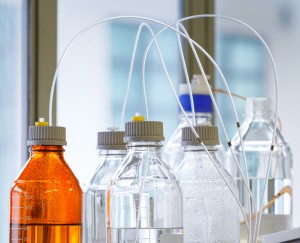What do fine win e, gourmet cheese and Brad Pitt have in common with one of the most-widely used and useful methods of separation analysis? They all get better with age — just like High-Performance Liquid Chromatography (HPLC)!
e, gourmet cheese and Brad Pitt have in common with one of the most-widely used and useful methods of separation analysis? They all get better with age — just like High-Performance Liquid Chromatography (HPLC)!
Alright, we’ll admit including Brad Pitt in that list might be a matter of opinion, but there’s no question that HPLC has matured into one fine analytical tool in the 50 or so years it’s been around. C&E News recently published an insightful retrospective on the five-decade history of HPLC that makes it clear why this testing method has become a leading form of liquid chromatography for separating and qualifying small molecules and polymers.
HPLC employs a mobile phase, forced by high pressure (6,000-9,000 psi) through a column. A liquid sample is introduced into a thin, stainless steel column, traveling through vacuum-tight connectors that sustain high pressure throughout the system. Columns are packed with tiny particles of a stationary phase that are porous and/or interact chemically with sample components to separate them. When the separated components exit the column, scientists can use a detecting device — mass spectrometer, evaporative light scattering, refractive index and others — to quantitatively analyze the components.
Origins of HPLC
In 1966, Yale University researchers published a paper on ion-exchange separation of organic compounds. A year later, they published on fast liquid chromatography using a higher-pressure pump. In 1967, Waters Associates began marketing what many view as the first commercial HPLC instrument.
C&E cites 1969 as a watershed year for HPLC. Prior to that year, gas chromatography was the separation analysis method of choice for a variety of applications. A series of meetings in Las Vegas sparked interest in the then-emerging technology as an alternative to GC, which only worked for volatile compounds or ones that had been derivatized to become volatile. HPLC was capable of analyzing a broader range of compounds, making it more valuable in applications such as drug discovery and biological separations, C&E reports.
The first 6,000-psi HPLC devices were introduced in 1972, and the addition of septumless injectors evolved the “P” in HPLC from “pressure” to “performance.” During the 1980s, chromatographers developed new separation methods and detectors to improve and expand the usability of HPLC into a variety of applications.
The 21st century has seen still more evolution in HPLC. New systems contain extremely small particles and higher pressures (15,000-20,000 psi). Faster analysis has long been a primary objective for HPLC development. Multi-dimensional HPLC addresses that demand by using two or more columns in sequence. Two-dimensional HPLC combines two chromatography modes — such as size exclusion and reverse phase — in which the output from one column feeds into a second. Each column has particles designed to separate different components.
Every day, HPLC helps scientists answer important questions about everything from food and beverage to medicines, household cleaners, pesticides and more. At 50, HPLC is going strong and getting better with every passing year!
